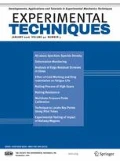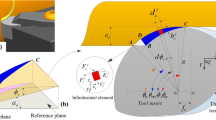Abstract
By altering the cutting edge profile, edge preparation can increase the stability of the cutting process, extend the tool life, and improve the machined surface quality. Herein, a theoretical model of cutting force based on milling tool edge preparation is established according to metal cutting theory and material constitutive equations. The influence of edge radius, milling speed, tool feed, cutting depth, and rake angle on the cutting force are investigated. The results of simulations of the tool milling force of a cemented carbide tool milling 45 steel were performed in the metal cutting modeling software AdvantEdge. Theoretical values of cutting force and torque are compared corresponding values obtained through the milling simulations and cutting experiments, respectively, to verify the proposed cutting force model based on edge preparation. The research results provide the basis for realizing the tool edge preparation effect, the high speed and the high efficiency cutting.















Similar content being viewed by others
Abbreviations
- F s :
-
Shear force
- F C :
-
Cutting force in the tool feed direction
- F P :
-
Axial cutting force
- h :
-
Cutting thickness
- a e :
-
Radial cutting depth
- a p :
-
Cutting depth
- δ :
-
Spiral angle
- f z :
-
Feed engagement
- φ :
-
Cut-out angle
- ω :
-
Cutting angle
- d :
-
Milling tool diameter
- γ 0 :
-
Rake angle
- β :
-
Friction angle of the rake face
- ϕ :
-
Shear angle
- V :
-
Cutting speed
- b :
-
Contact length between the tool and the chip
- τ :
-
Material flow stress in the shear zone
- ρ :
-
Angle between the chip and the uncut layer
References
Bernhard K, Schmidta K, Beňob J (2014) Measuring procedures of cutting edge preparation when hard turning with coated ceramics tool inserts. Measurement 55:627–640
Denkena B, Biermann D (2014) Cutting edge geometries. CIRP Ann Manuf Technol 63 (2):631–653
Bouzakis K, Bouzakis E, Kombogiannis S, Makrimallakis S, Skordaris G, Michailidis N, Charalampous P, Paraskevopou-lou R, M’Saoubi R, Aurich J (2014) Effect of cutting edge prepara-tion of coated tools on their performance in milling various materials. CIRP J Manuf Sci Technol 7:264–73
Rubeo MA, Schmitz TL (2016) Milling force modeling: a comparison of two approaches[J]. Procedia Manuf 5:90–105
Weng J, Zhuang K, Hug C (2020) A PSO-based semi-analytical force prediction model for chamfered carbide tools considering different material flow state caused by edge ge-ometry. Int J Mech Sci, 1691
Magalhães FC, Ventura CEH, Abrão AM, Denkena B (2020) Experimental and numerical analysis of hard turning with multi-chamfered cutting edges. J Manuf Process 49:126–134
Agmell M, Ahadi A, Gutnichenko O, Stahl J-E (2017) The influence of tool micro-geometry on stress distribution in turning opera-tions of AISI 4140 by FE analysis. Int J Adv Manuf Technol 89:3109–22
Zhou L, Peng F, Yan R, Yao P, Yang C, Li B (2015) Analytical modeling and experimental validation of micro end-milling cutting forces considering edge radius and material strength-ening effects. Int J Mach Tool Manu 97:29–41
Fulemova J, Janda Z (2014) Influence of the cutting edge radius and the cutting edge preparation on tool life and cutting forces at inserts with wiper geometry. Procedia Eng 69:565–573
Wang F, Yin J, Ma J et al (2017) Effects of cutting edge radius and fiber cutting angle on the cutting-induced surface damage in machining of unidirectional CFRP composite laminates. Int J Adv Manuf Technol 91:3107–3120
Zhu K, Li K, Mei T et al (2016) Research progress in micro-milling force modeling[J]. J Mech Eng 52(17):20–30
Sauer K, Witt M, Putz M (2019) Influence of cutting edge radius on process forces in orthogonal machin-ing of carbon fibre reinforced plastics (CFRP). Procedia CIRP 85:218–223
Denkena B, Vehmeyer J, Niederwestberg D, Maaß P (2014) Identi-fication of the specific cutting force for geometrically defined cutting edges and varying cutting conditions. Int J Mach Tools Manuf 82-83:42–9
Denkena B, Lucas A, Bassett E (2011) Effects of the cutting edge microgeometry on tool wear and its thermo-mechanical load. CIRP Ann 60:73–6
Oxley PLB, Young HT (1990) The mechanics of machining: an analytical approach to assessing machinability[J]. Ellis Hor-wood Publisher, Chichester, England
Merchant ME (1945) Mechanics of the metal cutting process[J]. I. Orthogonal cutting and a type 2 chip. J Appl Phys (16):267–275
Dudzinski D, Molinari A (1997) A modelling of cutting for visco-plastic materials[J]. Int J Mech Sci (39):369– 389
Su JC (2006) Residual stress modeling in machining processes[J]. Georgia Institute of Technology
Waldorf DJ, DeVor RE, Kapoor SG (1998) A slip-line field for ploughing during orthogonal cutting[J]. J Manuf Sci Eng (120):693–699
Kang IS, Kim JS, Kim JH, Kang MC, Seo YW (2006) A mecha-nistic model of cutting force in the micro end milling pro-cess[J]. J Mater Process Tech 187
Funding
This work is supported by the National Natural Science Foundation of China.(Research on the influence of tool passivation and asymmetric cutting edge on cutting performance),China.
Author information
Authors and Affiliations
Contributions
Xuefeng ZHAO: Graduate tutors, put forward research topics; Design the research plan; Obtaining research funding;
Yong YANG:Master’s degree student and Research and organize literature; Design the framework of the thesis; Draft papers; Revise the thesis;
Lin He: Supervisor of the master degree dissertation;
Zhiguo Feng: Supervisor of the master degree dissertation.
Corresponding author
Additional information
Publisher’s Note
Springer Nature remains neutral with regard to jurisdictional claims in published maps and institutional affiliations.
Yong Yang, Lin He and Zhiguo Feng contributed equally to this work.
Rights and permissions
About this article
Cite this article
Zhao, X., Yang, Y., He, L. et al. Experiment and Modeling of Milling Force Based on Tool Edge Preparation. Exp Tech 46, 761–773 (2022). https://doi.org/10.1007/s40799-021-00517-6
Received:
Accepted:
Published:
Issue Date:
DOI: https://doi.org/10.1007/s40799-021-00517-6




